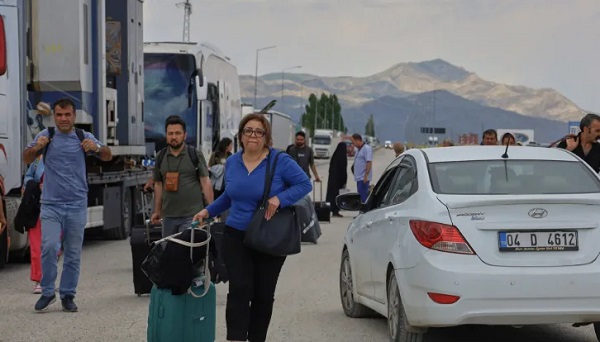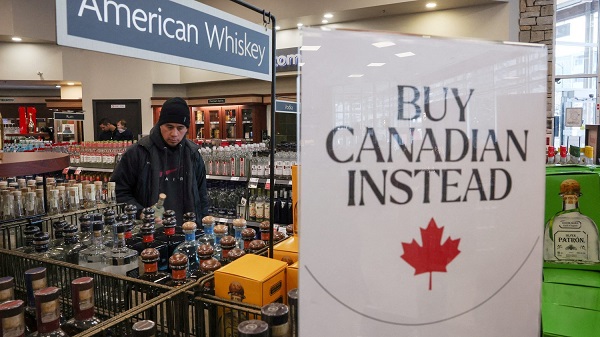Uncategorized
Michael charges into Southeast after slamming north Florida

PANAMA CITY, Fla. — The most powerful hurricane on record to hit Florida’s Panhandle left wide destruction and at least two people dead and wasn’t nearly finished Thursday as it crossed Georgia, now as a tropical storm, toward the Carolinas, that are still reeling from epic flooding by Hurricane Florence.
A day after the supercharged storm crashed ashore amid white sand beaches, fishing towns and military bases, Michael was no longer a Category 4 monster packing 155 mph (250 kph) winds. As the tropical storm continued to weaken it was still menacing the Southeast with heavy rains, blustery winds and possible spinoff tornadoes.
Authorities said at least two people have died, a man killed by a tree falling on a Panhandle home and according to WMAZ-TV, an 11-year-old girl was also killed by a tree falling on a home in southwest Georgia. Search and rescue crews were expected to escalate efforts to reach hardest-hit areas and check for anyone trapped or injured in the storm debris.
The National Hurricane Center in Miami said early Thursday that the eye of Michael was about 90 miles (144
After daylight Thursday residents of north Florida would just be beginning to take stock of the enormity of the disaster.
Damage in Panama City near where Michael came ashore Wednesday afternoon was so extensive that broken and uprooted trees and downed power lines lay nearly everywhere. Roofs were peeled away, sent airborne, and homes were split open by fallen trees. Twisted street signs lay on the ground. Palm trees whipped wildly in the winds. More than 380,000 homes and businesses were without power at the height of the storm.
Vance Beu, 29, was staying with his mother at her home, Spring Gate Apartments, a complex of single-story wood frame buildings where they piled up mattresses around themselves for protection. A pine tree punched a hole in their roof and his ears even popped when the barometric pressure went lower. The roar of the winds, he said, sounded like a jet engine.
“It was terrifying, honestly. There was a lot of noise. We thought the windows were going to break at any time,” Beu said.
Sally Crown rode out Michael on the Florida Panhandle thinking at first that the worst damage was the many trees downed in her yard. But after the storm passed, she emerged to check on the cafe she manages and discovered a scene of breathtaking destruction.
“It’s absolutely horrendous. Catastrophic,” Crown said. “There’s flooding. Boats on the highway. A house on the highway. Houses that have been there forever are just shattered.”
A Panhandle man was killed by a tree that toppled on a home, Gadsden County Sheriff’s Office spokeswoman Anglie Hightower said. But she added emergency crews trying to reach the home were hampered by downed trees and debris blocking roadways. The debris was a problem in many coastal communities and still hundreds of thousands of people were also left without power.
Gov. Rick Scott announced afterward that thousands of law enforcement officers, utility crews and search and rescue teams would now go into recovery mode. He said “aggressive” search and rescue efforts would get underway.
“Hurricane Michael cannot break Florida,” Scott vowed.
Michael sprang quickly from a weekend tropical depression, going from a Category 2 on Tuesday to a Category 4 by the time it came ashore. It forced more than 375,000 people up and down the Gulf Coast to evacuate as it gained strength quickly while crossing the eastern Gulf of Mexico toward north Florida. It moved so fast that people didn’t’ have much time to prepare, and emergency authorities lamented that many ignored the warnings and seemed to think they could ride it out.
In Panama City, plywood and metal flew off the front of a Holiday Inn Express. Part of the awning fell and shattered the glass front door of the hotel, and the rest of the awning wound up on vehicles parked below it.
“Oh my God, what are we seeing?” said evacuee Rachel Franklin, her mouth hanging open.
Based on its internal barometric pressure, Michael was the third most powerful hurricane to hit the U.S. mainland, behind the unnamed Labor Day storm of 1935 and Camille in 1969. Based on wind speed, it was the fourth-strongest, behind the Labor Day storm (184 mph, or 296 kph), Camille and Andrew in 1992.
It also brought the dangers of a life-threatening storm surge.
In Mexico Beach, population 1,000, the storm shattered homes, leaving floating piles of lumber. The lead-
Hours earlier, meteorologists watched satellite imagery in complete awe as the storm intensified.
“We are in new territory,” National Hurricane Center Meteorologist Dennis Feltgen wrote on Facebook. “The historical record, going back to 1851, finds no Category 4 hurricane ever hitting the Florida panhandle.”
The storm is likely to fire up the debate over global warming. Scientists say global warming is responsible for more intense and more frequent extreme weather, such as storms, droughts, floods and fires. But without extensive study, they cannot directly link a single weather event to the changing climate.
After Michael left the Panhandle late Wednesday, Kaylee O’Brien was crying as she sorted through the remains of the apartment she shared with three roommates at Whispering Pines apartments, where the smell of broken pine trees was thick in the air. Four pine trees had crashed through the roof of her apartment, nearly hitting two people.
Her biggest worry: finding her missing 1-year-old Siamese cat, Molly.
“We haven’t seen her since the tree hit the den. She’s my baby,” a distraught O’Brien said, her face wet with tears.
___
Associated Press writers Tamara Lush in St. Petersburg, Florida; Terry Spencer in Fort Lauderdale, Fla.; Freida Frisaro in Miami; Brendan Farrington in St. Marks, Florida; Russ Bynum in Keaton Beach, Florida; Jonathan Drew in Raleigh, North Carolina; and Seth Borenstein in Kensington, Maryland, contributed to this story.
___
For the latest on Hurricane Michael, visithttps://www.apnews.com/tag/Hurricanes
Jay Reeves And Brendan Farrington, The Associated Press
Uncategorized
Kananaskis G7 meeting the right setting for U.S. and Canada to reassert energy ties


Energy security, resilience and affordability have long been protected by a continentally integrated energy sector.
The G7 summit in Kananaskis, Alberta, offers a key platform to reassert how North American energy cooperation has made the U.S. and Canada stronger, according to a joint statement from The Heritage Foundation, the foremost American conservative think tank, and MEI, a pan-Canadian research and educational policy organization.
“Energy cooperation between Canada, Mexico and the United States is vital for the Western World’s energy security,” says Diana Furchtgott-Roth, director of the Center for Energy, Climate and Environment and the Herbert and Joyce Morgan Fellow at the Heritage Foundation, and one of America’s most prominent energy experts. “Both President Trump and Prime Minister Carney share energy as a key priority for their respective administrations.
She added, “The G7 should embrace energy abundance by cooperating and committing to a rapid expansion of energy infrastructure. Members should commit to streamlined permitting, including a one-stop shop permitting and environmental review process, to unleash the capital investment necessary to make energy abundance a reality.”
North America’s energy industry is continentally integrated, benefitting from a blend of U.S. light crude oil and Mexican and Canadian heavy crude oil that keeps the continent’s refineries running smoothly.
Each day, Canada exports 2.8 million barrels of oil to the United States.
These get refined into gasoline, diesel and other higher value-added products that furnish the U.S. market with reliable and affordable energy, as well as exported to other countries, including some 780,000 barrels per day of finished products that get exported to Canada and 1.08 million barrels per day to Mexico.
A similar situation occurs with natural gas, where Canada ships 8.7 billion cubic feet of natural gas per day to the United States through a continental network of pipelines.
This gets consumed by U.S. households, as well as transformed into liquefied natural gas products, of which the United States exports 11.5 billion cubic feet per day, mostly from ports in Louisiana, Texas and Maryland.
“The abundance and complementarity of Canada and the United States’ energy resources have made both nations more prosperous and more secure in their supply,” says Daniel Dufort, president and CEO of the MEI. “Both countries stand to reduce dependence on Chinese and Russian energy by expanding their pipeline networks – the United States to the East and Canada to the West – to supply their European and Asian allies in an increasingly turbulent world.”
Under this scenario, Europe would buy more high-value light oil from the U.S., whose domestic needs would be back-stopped by lower-priced heavy oil imports from Canada, whereas Asia would consume more LNG from Canada, diminishing China and Russia’s economic and strategic leverage over it.
* * *
The MEI is an independent public policy think tank with offices in Montreal, Ottawa, and Calgary. Through its publications, media appearances, and advisory services to policymakers, the MEI stimulates public policy debate and reforms based on sound economics and entrepreneurship.
As the nation’s largest, most broadly supported conservative research and educational institution, The Heritage Foundation has been leading the American conservative movement since our founding in 1973. The Heritage Foundation reaches more than 10 million members, advocates, and concerned Americans every day with information on critical issues facing America.
Uncategorized
Poilievre on 2025 Election Interference – Carney sill hasn’t fired Liberal MP in Chinese election interference scandal

From Conservative Party Communications
“Yes. He must be disqualified. I find it incredible that Mark Carney would allow someone to run for his party that called for a Canadian citizen to be handed over to a foreign government on a bounty, a foreign government that would almost certainly execute that Canadian citizen.
“Think about that for a second. We have a Liberal MP saying that a Canadian citizen should be handed over to a foreign dictatorship to get a bounty so that that citizen could be murdered. And Mark Carney says he should stay on as a candidate. What does that say about whether Mark Carney would protect Canadians?
“Mark Carney is deeply conflicted. Just in November, he went to Beijing and secured a quarter-billion-dollar loan for his company from a state-owned Chinese bank. He’s deeply compromised, and he will never stand up for Canada against any foreign regime. It is another reason why Mr. Carney must show us all his assets, all the money he owes, all the money that his companies owe to foreign hostile regimes. And this story might not be entirely the story of the bounty, and a Liberal MP calling for a Canadian to be handed over for execution to a foreign government might not be something that the everyday Canadian can relate to because it’s so outrageous. But I ask you this, if Mark Carney would allow his Liberal MP to make a comment like this, when would he ever protect Canada or Canadians against foreign hostility?
“He has never put Canada first, and that’s why we cannot have a fourth Liberal term. After the Lost Liberal Decade, our country is a playground for foreign interference. Our economy is weaker than ever before. Our people more divided. We need a change to put Canada first with a new government that will stand up for the security and economy of our citizens and take back control of our destiny. Let’s bring it home.”
-

 International2 days ago
International2 days agoTrump not seeking ceasefire with Israel, Iran as he rushes back to White House
-

 Business2 days ago
Business2 days agoThe CBC is a government-funded giant no one watches
-

 conflict2 days ago
conflict2 days agoTrump Threatens Strike on Khamenei as Israel Pounds Iranian Military Command
-

 conflict2 days ago
conflict2 days agoMiddle East clash sends oil prices soaring
-

 Business17 hours ago
Business17 hours agoCanada’s economic pain could be a blessing in disguise
-

 Business16 hours ago
Business16 hours agoRhetoric—not evidence—continues to dominate climate debate and policy
-

 Alberta2 days ago
Alberta2 days agoAlberta is investing up to $50 million into new technologies to help reduce oil sands mine water
-

 conflict13 hours ago
conflict13 hours agoTrump dismisses US intelligence that Iran wasn’t pursuing nuclear bomb before Israeli attack






